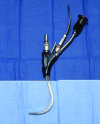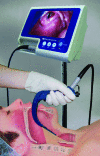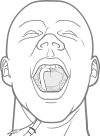Comprehensive airway management of patients with maxillofacial trauma
- PMID: 22110788
- PMCID: PMC3052732
- DOI: 10.1055/s-0028-1098962
Comprehensive airway management of patients with maxillofacial trauma
Abstract
Airway management in patients with maxillofacial trauma is complicated by injuries to routes of intubation, and the surgeon is frequently asked to secure the airway. Airway obstruction from hemorrhage, tissue prolapse, or edema may require emergent intervention for which multiple intubation techniques exist. Competing needs for both airway and surgical access create intraoperative conflicts during repair of maxillofacial fractures. Postoperatively, edema and maxillomandibular fixation place the patient at risk for further airway compromise.
Keywords: Airway obstruction; facial injuries; intubation; jaw fractures; laryngeal masks; mandibular fractures; maxillary fractures; maxillofacial injuries; tracheostomy.
Figures









Similar articles
-
Airway management in patients with maxillofacial trauma - A retrospective study of 177 cases.Saudi J Anaesth. 2011 Jan;5(1):9-14. doi: 10.4103/1658-354X.76476. Saudi J Anaesth. 2011. PMID: 21655009 Free PMC article.
-
Airway management in maxillofacial trauma: do we really need tracheostomy/submental intubation.J Clin Diagn Res. 2014 Mar;8(3):77-9. doi: 10.7860/JCDR/2014/7861.4112. Epub 2014 Mar 15. J Clin Diagn Res. 2014. PMID: 24783087 Free PMC article.
-
Management of laryngo-tracheal injuries associated with craniomaxillofacial trauma.J Oral Maxillofac Surg. 2006 Feb;64(2):203-14. doi: 10.1016/j.joms.2005.10.034. J Oral Maxillofac Surg. 2006. PMID: 16413891
-
Changing indications for tracheostomy in maxillofacial trauma.J Oral Maxillofac Surg. 1996 Mar;54(3):292-5; discussion 295-6. doi: 10.1016/s0278-2391(96)90744-2. J Oral Maxillofac Surg. 1996. PMID: 8600235 Review.
-
Submental intubation in oral maxillofacial surgery: review of the literature and analysis of 13 cases.Med Oral Patol Oral Cir Bucal. 2008 Mar 1;13(3):E197-200. Med Oral Patol Oral Cir Bucal. 2008. PMID: 18305443 Review.
Cited by
-
Quest for an Ideal Route of Intubation for Oral and Maxillofacial Surgical Manoeuvres.J Maxillofac Oral Surg. 2016 Jun;15(2):207-16. doi: 10.1007/s12663-015-0812-3. Epub 2015 Jun 13. J Maxillofac Oral Surg. 2016. PMID: 27298544 Free PMC article.
-
Vertically unstable fractured mandibular segment with attached genial tubercles as a parameter for difficulty during intubation for general anaesthesia.J Maxillofac Oral Surg. 2015 Mar;14(1):13-6. doi: 10.1007/s12663-013-0610-8. Epub 2014 Jan 14. J Maxillofac Oral Surg. 2015. PMID: 25729221 Free PMC article.
-
Anterior Submandibular Approach for Transmylohyoid Endotracheal Intubation: A Reappraisal with Prospective Study in 206 Cases of Craniomaxillofacial Fractures.Craniomaxillofac Trauma Reconstr. 2017 Dec;10(4):255-262. doi: 10.1055/s-0037-1607063. Epub 2017 Sep 27. Craniomaxillofac Trauma Reconstr. 2017. PMID: 29109835 Free PMC article.
-
Intra-Operative Airway Management in Patients with Maxillofacial Trauma having Reduction and Immobilization of Facial Fractures.Niger J Surg. 2015 Jan-Jun;21(1):26-30. doi: 10.4103/1117-6806.152721. Niger J Surg. 2015. PMID: 25838762 Free PMC article.
-
Craniomaxillofacial trauma: synopsis of 14,654 cases with 35,129 injuries in 15 years.Craniomaxillofac Trauma Reconstr. 2012 Mar;5(1):41-50. doi: 10.1055/s-0031-1293520. Craniomaxillofac Trauma Reconstr. 2012. PMID: 23449961 Free PMC article.
References
-
- American College of Surgeons. Committee on Trauma Advanced Trauma Life Support Program for Doctors. 7th ed. Chicago: American College of Surgeons; 2004.
-
- Tung T C, Tseng W S, Chen C T, et al. Acute life-threatening injuries in facial fracture patients: a review of 1,025 patients. J Trauma. 2000;49:420–424. - PubMed
-
- Dunham C M, Barraco R D, Clark D E, et al. Guidelines for emergency tracheal intubation immediately after traumatic injury. J Trauma. 2003;55:162–179. - PubMed
-
- Ng M, Saadat D, Sinha U K. Managing the emergency airway in Le Fort fractures. J Craniomaxillofac Trauma. 1998;4:38–43. - PubMed
-
- Kellman R. The cervical spine in maxillofacial trauma: assessment and airway management. Otolaryngol Clin North Am. 1991;24:1–13. - PubMed
LinkOut - more resources
Full Text Sources
